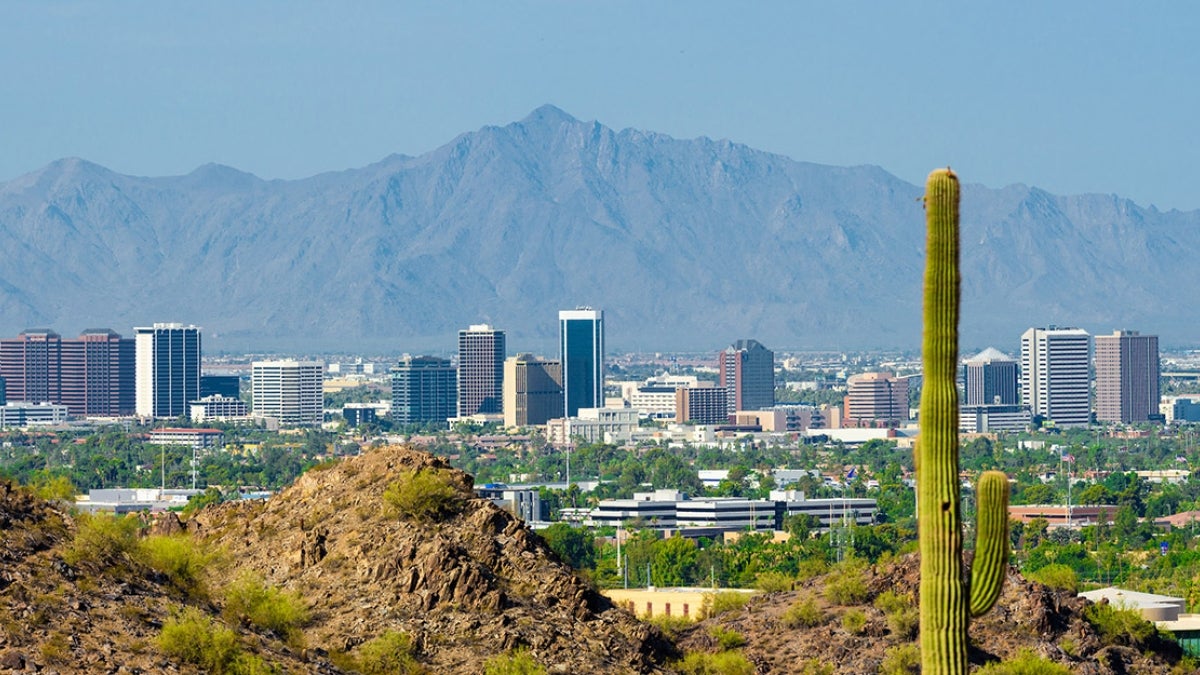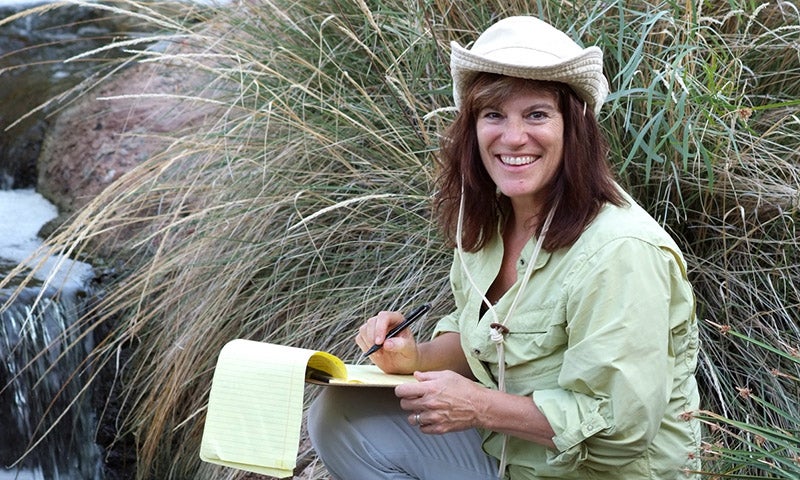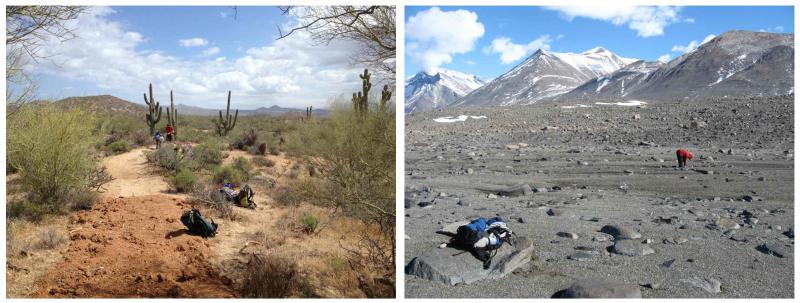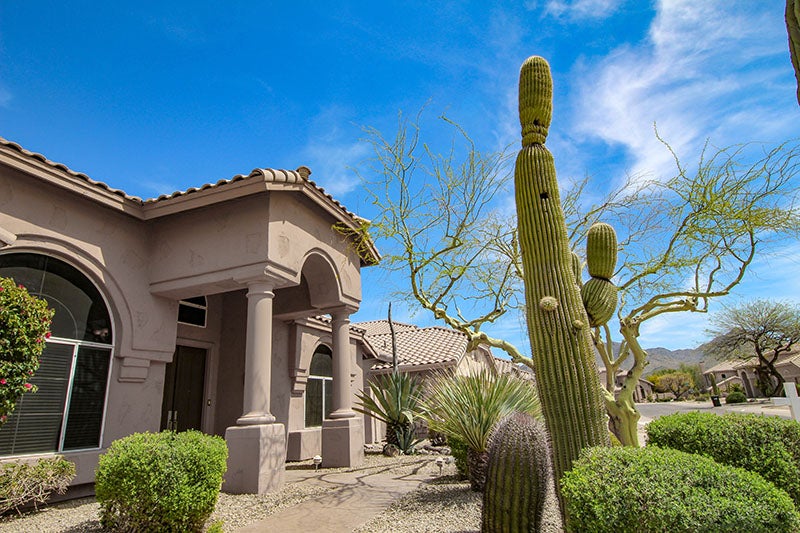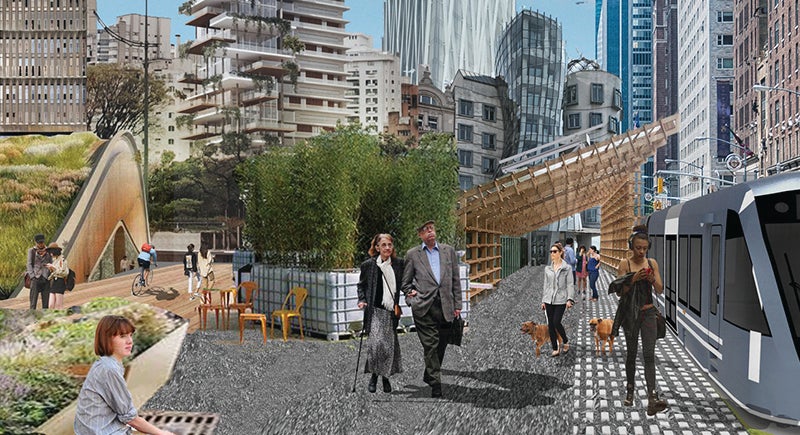More than half of all humans worldwide — and over 80% in the U.S. — live in cities. Yet when we think about studying the environment, we often think about everywhere but cities.
For the past 25 years, scientists at Arizona State University have been studying the Phoenix metropolitan area as an ecosystem of its own — complete with critters and cacti, snakes and lakes, pavement and, of course, people.
“Cities are ecosystems. And they’re different because they have a built environment and they have a very, very dominant species — people — that operate by different rules. We have culture and institutions and things that other species don’t,” says Nancy Grimm, a Regents Professor in the School of Life Sciences at ASU.
Grimm is a founding director of the Central Arizona-Phoenix Long-Term Ecological Research (CAP LTER) project. CAP LTER is part of the National Science Foundation’s Long Term Ecological Research (LTER) Network, started in 1980. LTER sites advance our understanding of the nation’s ecosystems and inform scientists, policymakers and the public with the knowledge needed to conserve and protect them.
CAP LTER scientists explore how people, nature and the built environment interact in urban Phoenix. Photo by Tim Trumble
CAP LTER has been funded continuously since 1997. This month, the NSF announced that it will provide nearly $8 million to support the program for another six years.
There are 28 active LTER sites around the country, but only two are located in cities. ASU’s is one.
“Homo sapiens is an urban species,” says Dan Childers, current director of CAP LTER and a professor in the School of Sustainability. “So understanding the social, ecological and technological dynamics that are at work in urban ecosystems is critical.”
Phoenix’s location is important, too. The desert southwest includes many of the fastest-growing cities in the U.S. Globally, arid and semi-arid environments cover over 30% of the world’s land surface and are home to a third of the world’s population.
“When we study urban ecology here, we’re studying Phoenix, but it’s essentially a microcosm of the way cities can, should and should not function in a fairly broad part of the globe,” says Childers.
The city as ecosystem
CAP LTER researchers have published over 800 articles in research journals to date. Their findings cover a vast range of topics about animals, plants, water, soils, infrastructure and human behavior — and the interactions among them.
More importantly, CAP LTER helped to build and shape the field of urban ecology, which barely existed when the program first started.
“CAP LTER and all of the students and faculty that have been through CAP over the past 25 years have very clearly put ASU on the map as a world-renowned powerhouse for urban systems research,” says Childers.
“There wasn’t a whole lot of urban ecology going on in the United States when we first got started. I think what distinguished our proposal at the very outset was that we were one of the few that actually took the view of the city as an ecosystem. Whereas many others were saying, ‘Cities are bad and they have a bad effect on neighboring environments,’” says Grimm, a stream ecologist who had not conducted research in cities before CAP LTER.
Nancy Grimm is a stream ecologist who led CAP LTER for nearly 20 years. Photo by Tim Trumble
She says the researchers took an ecosystem science approach at the start of CAP LTER. They tried to use physical and ecological data to make predictions about things like how many animals live in an area or how much nitrogen would be in the soil.
“But we found that we couldn’t, and we couldn’t because of the social dimension that has to be brought into that. What are the decisions people make about their environment? How long have people been manipulating the landscape?” she asks.
For example, when people grow crops, they add water and nitrogen (through fertilizer) to the soil. Some of the CAP LTER study areas were farmed for almost 100 years before being developed. And those areas are very different from parts of the city built on land that was never farmed.
“We found that variable — whether some piece of land had ever been farmed — was absolutely essential to understanding a lot of aspects of ecology in that system,” Grimm says.
Becky Ball also started her career studying natural ecosystems, not cities. In fact, a lot of her research takes place in one of the least populated places on Earth — Antarctica. But she says her research has always focused on the impacts of human activities, even when they aren’t apparent.
“I’m a soil biogeochemist. I study how biology interacts with geology to make chemistry happen in soils. I study how different chemical elements — carbon, nitrogen, phosphorus, all of the chemicals that keep us alive — move around in the ecosystem,” says Ball, an associate professor in the School of Mathematical and Natural Sciences who will become director of CAP LTER in the next funding cycle.
These chemical cycles are essential to all life on Earth. And they are heavily impacted by people.
“Most of the environmental problems we’re dealing with can be boiled down to us messing with a biogeochemical cycle. Climate change is us messing with the carbon cycle. Acid rain is us messing with the nitrogen cycle. Smog is us messing with the nitrogen and sulfur cycles,” she says.
Antarctica and Arizona have more in common than you might think. “They deal with a lot of the same extreme limitations on life,” says Becky Ball, who conducts research in both locations. Photos by Becky Ball
Farming isn’t the only way people add nitrogen to the environment. Burning fossil fuels puts nitrogen into the air, which then falls onto the land. Ball compares this nitrogen deposition in urban Phoenix and in desert preserves outside the city core, such as the Estrella and White Tank Mountains.
One thing the research across CAP LTER shows time and again is that “natural” ecosystems inside the city, such as the South Mountain Park and Preserve, are very different from those outside it. For example, the diversity of many species — from birds to rodents — is lower inside the city than in the surrounding desert. There may be the same number of animals, but fewer different kinds.
“So despite the fact that South Mountain looks like the other mountains, there are differences in the community because of the things that we do,” Ball says.
Perception is everything
Kelli Larson is a professor in the School of Geographical Sciences and Urban Planning and the lead social scientist for CAP LTER. She studies people’s perceptions about their environment and how that affects their decision-making.
Larson directs the Phoenix Area Social Survey (PASS), which is conducted every five years in diverse neighborhoods across the metro area.
“We often think we understand why people do what they do. We like to position ourselves as rational beings who make good choices. But social science research has found that there are so many contradictions and paradoxes,” she says.
For example, residential yards in the Valley have increasingly shifted from grass lawns to desert landscaping over time. Many people assume this happened because homeowner preferences changed, perhaps out of a desire to reduce water use.
However, research suggests the shift didn’t come primarily from residents. The environmental movement in the 1970s brought about changes in the landscape architecture industry. This changed the landscape designs that developers built. At the same time, nurseries increased their stock of low-water-use plants for residents to buy.
“These broader-scale forces are more important than individual decisions,” says Larson. “We see a mismatch sometimes between what people have and what they prefer. In our 2017 survey, it basically showed that people want more grass than they have.”
More Phoenix-area homes sport desert landscaping today than in the past, but many people still want grass lawns, say CAP LTER scientists. Photo courtesy Shutterstock
Another common assumption is that newcomers from the Midwest and East Coast are demanding grass lawns. Studies have shown the opposite is true — longtime Phoenicians prefer grass more than recent transplants.
Understanding how people perceive their environment is important because it’s not enough to know which plants and animals will benefit the ecosystem. They must also be appreciated and maintained by people if they are going to thrive.
One unique feature of CAP LTER is that the researchers are collecting survey and ecological data in the same locations. For example, biologists counted bird species in neighborhoods where social scientists conducted PASS. Then they compared people’s satisfaction with the wildlife in their neighborhoods to the actual birds that live there.
“What we found is that where the bird communities are more diverse, you do see higher levels of satisfaction with those bird communities,” says Larson. This match between the reality of the environment and people’s perception also holds true for other features, such as extreme heat.
“And so, even in cities, people are more connected to the nature around them than they perhaps even know,” notes Childers.
Better nature
One of CAP LTER’s keystone findings has been that wildlife is more diverse and abundant in neighborhoods with higher-income residents.
“Where people of wealth live — and white, wealthy people predominantly — there tends to be higher diversity of organisms, more vegetation, more protection from heat and from flooding. This was something that we first found with vegetation, and we termed it the luxury effect,” says Grimm.
While “luxury effect” has become a popular phrase, Grimm says many people now think it’s too nice for the reality of the situation.
“It’s not so much that wealth creates the conditions that are better in the city, but that people who have been historically discriminated against live in areas that have been degraded — often purposely — through the siting of toxic industrial plants, through bad zoning, through redlining,” she explains.
The next phase of CAP LTER will focus even more on these kinds of environmental justice issues. Phoenix is well positioned for this work. Other LTERs are mostly located in remote areas that people must choose and have the means to visit. Any study of human perceptions of these environments will be biased from the start.
“Everybody experiences Phoenix, whether they want to or not, if they live here. And so we have a lot of opportunities to make a positive impact by looking at who experiences heat, who has access to nature,” Ball says.
The team has already worked extensively in South Phoenix, which has a high Latino and Black population. In the upcoming funding cycle, they will expand their work into other underserved neighborhoods, as well as working with tribal communities.
“We have brought on some new researchers in CAP who aren’t just Indigenous themselves, but they do Indigenous community work. We’re really excited that we’re being more inclusive geographically and culturally in the work that we’re doing here,” says Childers.
“I think the recognition we’re having now is that we are on land that was stolen from the people that were here. Those communities are not gone. Living in this environment, we need a better understanding of the people who have lived here for much, much longer than any of the settlers have,” adds Grimm.
A more intentional future
This inclusive approach is particularly important for CAP LTER’s scenarios and futures work. This team works with a mix of stakeholders, such as government officials, community leaders, religious leaders and nonprofit groups. Together, the researchers and stakeholders ask what the long-term future of Phoenix could look like, and how we can get there.
“Before CAP LTER, there were a number of groups doing participatory research with urban ecology, but it was more like the citizen science approach, or they were being surveyed or interviewed. But we are co-producing the research questions and the approach and the solutions together,” says David Iwaniec.
Iwaniec began working with CAP LTER when he was a graduate student in the School of Sustainability. After earning his PhD, he stayed at ASU as a postdoc and then an assistant research professor. Now he is an assistant professor in the Urban Studies Institute at Georgia State University, but he continues to co-lead CAP LTER’s scenarios and futures work.
The team starts by looking at the stakeholders’ existing plans, such as a city’s five-year plan, and projecting out 20 or 30 years to see the longer-term implications. Then they ask the participants if this is what they want for their neighborhood, city or region.
Through this process, the stakeholders identify the biggest challenges they are facing. Next, they develop scenarios to help address those challenges.
“For example, what might be ways to address heat in equitable ways, so that we don’t have gentrification associated with reducing heat to our most vulnerable communities?” says Iwaniec.
Watch an example of a scenario designed to address challenges. Video courtesy CAP LTER
Once the groups have examined their goals and created scenarios to address the challenges that remain, they create transformative scenarios. This moves the conversation from how to avoid a negative future to how to move toward the future we want. Stakeholders get to ask, “What if?”
“I think transportation is a really great example of that, because Phoenix is defined by the automobile. What if, in 50 years, technology has been developed that allows us to no longer rely on cars? What could we do with a Phoenix that’s been built on the basis of automobiles?” asks Iwaniec.
All of the scenarios rely on decades’ worth of data collected by CAP LTER. These help participants understand the long-term implications of different decisions. For example, if stakeholders suggest planting trees to create shade, they can calculate how that will affect water supplies.
The CAP LTER team translates these scenarios into animations to reach broader audiences. Importantly, they also format the scenarios as policy documents.
“We actually format them for a city planner, for example, as if it is one of their plans. And that bridges the science and policy divide even more, taking that extra step of making sure that the products match what they’re used to,” says Iwaniec.
Transformative scenarios help communities envision the future they want. Image courtesy CAP LTER
The team has brought the scenario process to multiple cities around the world, from New York to Valdivia, Chile, as well as Iwaniec’s new home, Atlanta.
In the next phase of CAP LTER, the team will focus on the pathways needed to make the transformational scenarios a reality. Once stakeholders have determined what the future could look like, this work will tell them how to get there.
This process has already begun in some places. For example, one scenario that was developed included the creation of a government office dedicated to addressing heat. In 2021, the city of Phoenix established the Office of Heat Response and Mitigation — the nation’s first publicly funded office focused on heat response. David Hondula, an associate professor in the School of Geographical Sciences and Urban Planning and a CAP LTER researcher, was named director of the new office.
“It shows how fast government structures can change,” says Iwaniec.
The CAP LTER team is also working with the leaders and stakeholders of tomorrow. The award-winning Ecology Explorers program shares CAP LTER research findings with K–12 teachers and students and involves them in real research projects. CAP LTER scientists are also working directly with schools in lower-income areas of South and West Phoenix. For example, they installed air quality monitors on school campuses. Students and teachers can access the information online to understand the air quality at their schools.
MORE: Explore ecology lesson plans, research activities and other classroom resources.
“I think that by understanding this environment as it is, we can potentially understand what it is about the environment that we could improve,” says Grimm. “How can we think about ways to transform this environment and really create a sustainable city? Not just some place that is tolerable to live in, but some place where people can thrive.”
CAP LTER is funded by the National Science Foundation through Grant No. 1832016. Any opinions, findings, conclusions or recommendations expressed in this material are those of the individual speakers and do not necessarily reflect the views of the National Science Foundation. CAP LTER is a unit of the Global Institute of Sustainability and Innovation.
Top photo of the Phoenix skyline by Andy DeLisle/ASU
More Environment and sustainability

2 ASU faculty elected as AAAS Fellows
Two outstanding Arizona State University faculty spanning the physical sciences, psychological sciences and science policy have been named Fellows of the American Association for the Advancement of…

Homes for songbirds: Protecting Lucy’s warblers in the urban desert
Each spring, tiny Lucy’s warblers, with their soft gray plumage and rusty crown, return to the Arizona desert, flitting through the mesquite branches in search of safe places to nest.But as urban…

Public education project brings new water recycling process to life
A new virtual reality project developed by an interdisciplinary team at Arizona State University has earned the 2025 WateReuse Award for Excellence in Outreach and Education. The national …


